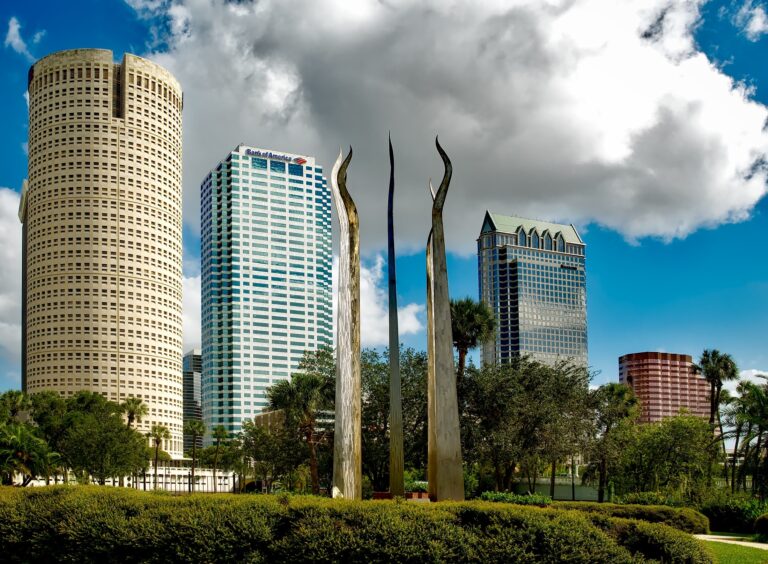
Tampa, Florida, known as the “Sunshine City,” is a vibrant and rapidly growing metropolitan area that presents exciting commercial real estate opportunities for out-of-state investors and individuals seeking a thriving business environment. In this blog post, we will delve into the various neighborhoods, economic factors, and key information that make Tampa an attractive destination for commercial real estate investments.
- Booming Economy and Business Climate: Tampa boasts a robust economy, with diverse industries driving its growth. The city’s strategic location, favorable tax environment, and pro-business policies make it an ideal choice for investors. Consider including statistics to illustrate Tampa’s economic prowess:
- The Tampa metropolitan area has a GDP of over $150 billion, making it one of the largest economies in Florida.
- The healthcare and life sciences sectors in Tampa have seen substantial growth, with an increase of 21% in jobs over the past five years.
- The technology and innovation sector has experienced a 53% increase in venture capital investment in the last three years.
- Neighborhood Spotlight: a) Downtown Tampa: The central business district offers a mix of commercial properties, including high-rise office buildings, retail spaces, and mixed-use developments. Highlight its proximity to major transportation hubs and the ongoing revitalization efforts, which have resulted in a 15% increase in commercial property values in the last two years. b) Channelside District: Located near the waterfront, Channelside offers a vibrant mix of entertainment venues, restaurants, and retail spaces. Emphasize its potential for hospitality, tourism, and retail-oriented businesses, given its annual visitor count of over 3 million people. c) Westshore Business District: Recognized as Tampa’s largest office market, Westshore features a range of Class A office spaces, hotels, shopping centers, and dining options. Discuss its connectivity to the Tampa International Airport, which serves over 22 million passengers annually, making it an ideal location for corporate tenants and businesses.
- Emerging Areas: a) Tampa Heights: This historic neighborhood is experiencing a resurgence, with new commercial developments, mixed-use projects, and a focus on sustainability. Highlight its potential for creative industries and trendy retail spaces, driven by a 30% increase in small businesses opening in the area in the past year. b) Ybor City: Known for its rich cultural heritage, Ybor City offers a unique blend of commercial and entertainment spaces, making it an attractive destination for restaurants, bars, and boutique shops. Mention its designation as a National Historic Landmark and its thriving nightlife scene.
- Infrastructure and Transportation: Discuss Tampa’s robust infrastructure, including the Port of Tampa, which facilitates international trade and commerce, handling over 37 million tons of cargo annually. Emphasize the ongoing expansion of the Tampa International Airport, serving as a major gateway with direct flights to over 80 destinations. Highlight the city’s well-connected road network, including the recently expanded I-4 corridor, which enhances accessibility for businesses and residents.
- Lifestyle and Attractions: Paint a picture of Tampa’s desirable quality of life, with its year-round pleasant climate, beautiful beaches, outdoor recreational opportunities, and cultural attractions such as the renowned Tampa Museum of Art and professional sports teams like the Tampa Bay Buccaneers. Mention its designation as one of the “Best Places to Live” by U.S. News & World Report.
- Real Estate Market Trends: Provide an overview of the current commercial real estate market in Tampa, including property types, vacancy rates, rental yields, and projected growth. For example:
- Commercial office spaces in Tampa have seen a steady decrease in vacancy rates, with a current rate of 10%, indicating a high demand for office properties.
- Retail rental rates have increased by 7% over the past year, showcasing the market’s strength and potential for retail businesses.
- Tampa’s industrial real estate market has experienced significant growth, driven by e-commerce and logistics demands, with a vacancy rate of only 4%.
Conclusion: Tampa, with its thriving economy, diverse neighborhoods, and favorable business climate, presents a compelling case for out-of-state investors and individuals looking to tap into its commercial real estate market. Whether it’s downtown’s bustling business district, the revitalized neighborhoods, or the emerging areas, Tampa offers a range of opportunities for businesses to flourish. Stay informed, work with local experts, and seize the potential that this vibrant city has to offer.
Disclaimer: The information provided in this blog post is for informational purposes only and should not be construed as investment advice. It is recommended to conduct thorough research and consult with professionals before making any investment decisions.
